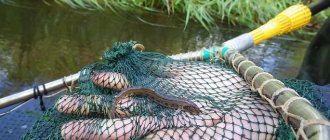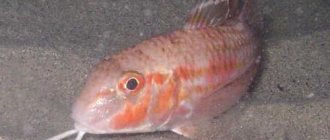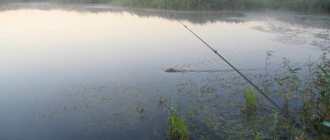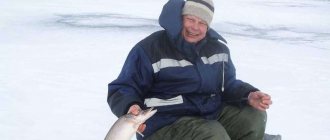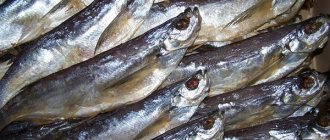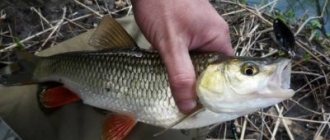Verkhovka fish belongs to miniature representatives of the carp family. It swims near the surface of the reservoir, which is why it got its name. The second name, “oatmeal,” was assigned to the fish due to its pale gray color. Verkhovka looks like a small bleak. In natural conditions it lives in the waters of Central and Eastern Europe, is suitable for breeding in an aquarium, and is of high value for fishermen.
Verkhovka always swims near the surface of the reservoir
Description of the fish
The average length of the common verkhovka is only 4-5 cm, but there are individual specimens up to 8 cm long. The weight of one fish is only 7 g. The sides of the common verkhovka are silvery, the back is slightly greenish, and a pronounced light blue stripe stretches along the sides. The fins are always colorless.
During the mating season, a “pearl rash” appears on the head of males, and thickening is observed in females in the area of the urogenital opening. The fish has large scales that are easily separated from the body. The head is cone-shaped, the lower jaw is slightly raised upward, the mouth section ends almost at eye level. The teeth are double-rowed, laterally compressed.
For habitat, the fish chooses reservoirs with a silty bottom, but constantly stays on the surface of the water. He leads a sedentary lifestyle and does not go on long journeys.
The top swimmer rarely changes bodies of water
Verkhovka habitats
- The Leucaspius delineatus family can be found in many freshwater bodies of Russia and other European countries. The recorded habitat is as follows:
- Rivers flowing into the Black Sea;
- Rivers of Central and Eastern Europe (from the Rhine to the Northern Dvina);
- Freshwater reservoirs of Transcaucasia;
- Basins of the Caspian, White and Baltic seas;
- Pools of the Dnieper and Pripyat.
The fish is not found only in Scandinavia and Siberia, where the water temperature is too low for its habitat and reproduction.
Keeping verkhovka in the aquarium
The top swimmer does not tolerate loneliness well, so it is better to purchase a whole school at once - 5-10 small fish. This will make it easier for them to adapt to new living conditions. During the day, the verkhovna floats on the surface of the aquarium, and at night it is located on the bottom.
Fish often jump out of the tank, so the aquarium should be filled only halfway or covered with a glass lid on top. The recommended tank volume for this type of fish is 30-40 liters. The water must be clean and oxygenated. It is important to adhere to the correct temperature, which depends on the time of year.
In summer, you need to maintain the water temperature at 24-25 ˚С, while in winter the verkhovka feels comfortable in water 12-14 ˚С. To create such conditions, in winter it is recommended to move the aquarium to a cool place, for example, on a windowsill.
Beware of the oatmeal's proximity to predators - small fish will certainly be eaten. In addition, these fish are very timid and, out of fear, begin to hit the walls of the aquarium, causing injury to themselves.
The fish becomes sexually mature in the second year of life, reaching a length of approximately 4 cm. Female eggs are laid on the surface of moss, fern, and arrowhead. Therefore, it is recommended to abundantly populate the aquarium with vegetation.
Externally, the masonry of the verkhovka looks like lines 1-2 eggs thick. Each clutch contains from 10 to 30 small transparent eggs. After about a week, each egg hatches into a larva, which immediately knows how to swim and get its own food.
You need to monitor the temperature of the water in the aquarium, otherwise the fish will die
Fish are susceptible to various diseases and require careful care. The average life expectancy is 3-4 years. The fish are very graceful; watching them actively move around the aquarium is a real pleasure.
Features of the behavior of the Verkhovna
Despite its small size, the verkhovka is very gluttonous and prefers animal food. It feeds on the larvae of various insects, small bugs, even the eggs and larvae of other fish. The fry eat zooplankton.
For reproduction, the verkhovka matures in the 2nd year of life, when its weight reaches 5 g and its body length is 4 cm. The first spawning occurs in early May and continues until the end of the first summer month. The first spawning occurs after the water temperature reaches 15 degrees Celsius, subsequent spawning occurs under more favorable conditions for the development of larvae.
Fish spawn on leaves of underwater vegetation. The total number of eggs in one clutch can be 4 thousand pieces. The size of one egg is slightly less than a millimeter. In total, fish live in the wild for 3 to 4 years.
Catching
Active biting occurs from the beginning of May and lasts until the end of October. In September and October, the bite occurs at depth, but does not become less active. Bleak is not of great commercial value. Often used as bait for larger fish: pike perch, pike, asp.
Lure
To start fishing, you need to scatter the bait. It is made from bran with the addition of oatmeal, oatmeal, and coarsely ground crackers. This mixture takes the longest time to sink to the bottom, creating a cloudy cloud in the water where the fishing rod is cast.
Tackle
lightweight flexible rod
Sinkers are used from several pellets, evenly distributed along the line, which allows you to control the bait after casting. The float is selected depending on the casting depth: in the near-surface layers - ratite, at a depth of more than 70 cm - keeled.
Bait
As a treat, a win-win option would be maggots, houseflies, and bloodworms. It bites well on the worm, but it breaks off more often.
Fishing technique
Fishing for bleak is usually done when there is a shortage of other, more valuable fish. For novice anglers, this fish has educational value: with its help, the fisherman trains to perform a quick and easy hook. The bleak takes the bait with lightning speed, and if there is no hooking, the bait is knocked down by it. But, if the maneuver is performed abruptly and too forcefully, the upper lip of the fish may not be able to withstand it and come off.
It is more convenient to fish from a bridge, steep bank or raft. When the fish hits the bait, it moves the float sharply to the side. It would be correct to move the rod forward slightly without removing the line from the water. With some skill, you manage to fish them out one by one.
Eating
For a long time, bleak was used only by commoners, only when there was a shortage of other fish. The dry consistency makes it unsuitable for fish soup. Tasty smoked, dried, fried in sour cream.
What does the verkhovka eat?
At first, the fry greedily feed on zooplankton, which includes rotifers and cladocerans. Next, the verkhovka begins to feed on various larvae, eats beetles, insects, and will not refuse fish eggs, being a very harmful fish in cultural reservoirs. During the daytime it feeds on mayflies, flies and other flying insects, and by night it goes to the depths, where it continues to feed, only now on zooplankton. Despite its small size, it is a very voracious fish.
Notes[ | ]
- Reshetnikov Yu. S., Kotlyar A. N., Rass T. S., Shatunovsky M. I.
Five-language dictionary of animal names. Fish. Latin, Russian, English, German, French. / under the general editorship of academician. V. E. Sokolova. - M.: Rus. lang., 1989. - P. 143. - 12,500 copies. — ISBN 5-200-00237-0. - Oatmeal // Encyclopedic Dictionary of Brockhaus and Efron: in 86 volumes (82 volumes and 4 additional). - St. Petersburg, 1890-1907.
- Verkhovka or oatmeal // Encyclopedic Dictionary of Brockhaus and Efron: in 86 volumes (82 volumes and 4 additional). - St. Petersburg, 1890-1907.
Types of bleak
The Azov-Black Sea shemaya is considered the closest relative of the bleak. Shemaya grows up to 35 cm in length and gains weight up to 800 grams. As a rule, the catches contain individuals weighing a little more than 200 grams. Shemaya got its name due to its excellent taste. Translated from Persian, shemaya means royal fish. The habitat of the king fish covers rivers included in the basins of the Black, Azov and Caspian seas, as well as slightly salted marine areas of the same seas. The shemai's diet includes insects, zooplankton, crustaceans, worms, larvae and small fish, although to a lesser extent. The appearance of the shemaya is practically no different from the bleak, except for its size, wider body and orange color of the pectoral fins.
Commercial use of verkhovka
Verkhovka does not have any special commercial significance. It is not caught for industrial processing, and the meat is rarely eaten due to the difficulties of processing. In some rivers and lakes, where there is a large amount of fish of this type, local residents catch it with the help of fishing rods and make fish cakes.
However, the verkhovka is ideal as live bait for catching larger predatory fish. Perch bites well on the top. The peculiarity of the fish is that it is easy to catch, it remains mobile for a long time in the cage and is easily transported. You can catch live bait for fishing directly from the surface of the reservoir using a thick net.
Bleak -Alburnus lucidus Heck
Bleak is one of the most common and well-known fish in the CIS, found almost everywhere. The body of the bleak is elongated, thin, covered with large steel-colored scales sparkling in the sun. The back is darker, gray-blue with a greenish tint, the sides and belly are silvery with a strong metallic sheen. The upper and lower fins of the bleak are dirty yellowish in color. The scales are very delicate and sit very loosely on the body, so they fall off at the slightest touch.
Bleak lives in almost all large and small rivers, and also inhabits flowing ponds and lakes with clean, transparent water and a sandy bottom. The bleak is extremely careful. For most of the year, bleak swims in schools at the surface of the water, and it stays at depth only in winter. Their favorite habitat is quiet, deep waters, and only occasionally it is caught on shallow riffles. Extremely lively and very agile, it is constantly on the move and scurries back and forth near the surface, looking for prey. She greedily rushes after a small midge or worm floating by. On warm summer evenings, immediately after sunset, when clouds of mosquitoes and midges hover just above the water, the bleaks become very agitated. Keeping in flocks, they then rush after swarms of mosquito mosquitoes and, jumping out of the water one after another, try to knock down the closest insects with splashes of water in order to refresh themselves. And a mosquito, once in the water, immediately becomes their easy prey.
Bleak matures quickly and begins to reproduce in the second year of life. Bleak usually begins spawning in mid-May and continues almost until the end of June. The bleak lays its eggs in shallow water on grass, tree branches or stones located near the very banks of a river or lake. The eggs are very small and numerous, and juveniles soon emerge from them.
In France, bleak scales are used to prepare the so-called oriental essence (Essence d'Orient), which is used to tint artificial pearls. The recipe for preparing this essence was invented back in the century before last, and since then it has been increasingly improved.
Editorial: Etroplus spotted
Currently, the preparation of oriental essence is carried out as follows. The scraped scales of the bleak are placed in water and stirred until there is no silver pigment left on it, which separates in the form of crystalline particles and settles to the bottom. Then all the scales are removed from the container, and a silvery sediment remains at the bottom of the vessel. This silvery liquid, after purification from impurities, is the famous Essence d'Orient.
To prepare pearls, take small blown glass balls and carefully add essence, drop by drop, through the holes, which, adhering to their inner surface, gives them the appearance of pearls. The more irregular the shape of these balls, the more they resemble real pearls, and they can be distinguished from real ones only by their weight
To obtain a pound of such essence you need 4 pounds of scales, which requires no more or less than 15,000 bleaks.
Among lovers of country holidays, garden ponds are becoming increasingly popular. Yes, not simple ones, but “living” ones - that is, inhabited by fish.
The inhabitants of such country ponds and their homes require close attention and careful care so that the owner can proudly talk about his experience in fish farming. Let's talk about who, how and why lives in the garden pond.
Usually, such an important task as the construction of a fish pond is undertaken by enthusiastic summer residents who are not afraid of “neither rain nor slush.” In our case - year-round care of the reservoir and its inhabitants. Especially for the residents... But that’s all later. At first the thought appears: I want a pond. Then the second: why not put some fish in there... A start has been made! Now it's a matter of technique.
